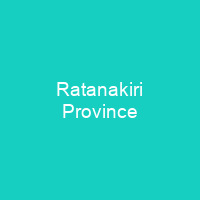Ratanakiri has been occupied by the highland Khmer Loeu people since at least the Stone or Bronze Age. The Khmer Rouge built its headquarters in the province in the 1960s, and bombing during the Vietnam War devastated the region. The U.N. has described the province as one of the least developed provinces of Cambodia; its infrastructure is poor, and the local government is weak.
About Ratanakiri Province in brief

The name Ratan Kakiri is formed from the Khmer words រតនៈ and គិᾚᾸ, describing two features for which the province is known: the Annamite Range and the Tonle Srepok River. The region was invaded by Annamites, the Cham, theKhmer, andthe Thai during its early history, but no empire ever brought the area under centralized control. In the 13th century or earlier until the 19th century, highland villages were often raided by Khmer, Lao, and Thai slave traders. The area was incorporated into French Indochina in 1893, and colonial rule replaced slave trading. The French built huge rubber plantations, especially in Labansiek ; indigenous workers were used for construction and rubber harvesting. Although highland groups initially resisted their colonial rulers, by the end of the colonial era in 1953 they had been subdued. In 1960, the government responded harshly, torching settlements and killing hundreds of ethnic minorities. The Communist Party of Kampuchea (CPK) forged an alliance with ethnic minorities in Ratanakiiri, exploiting resentment of the central government. During this period, there was also extensive Vietnamese activity in RatAnakiri. In 1969, Sihanouk said that Ratanakairi was “practically North of North Vietnam”, referring to the main towns of North and South Vietnam. The CPK joined the CPK in 1966, and hundreds of KhmerLoeu joined CPK units.
You want to know more about Ratanakiri Province?
This page is based on the article Ratanakiri Province published in Wikipedia (as of Dec. 03, 2020) and was automatically summarized using artificial intelligence.







